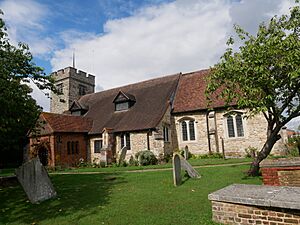All Saints, Chingford facts for kids
The Church of All Saints, Chingford, also known as Chingford Old Church, is a very old and important church building in Chingford, London. It's so special that it's listed as a Grade II* building, meaning it's of more than special interest. Some parts of this church are from the 12th and 13th centuries! Even though it's old, it's now part of a bigger church family called St Peter and St Paul, Chingford. That church took over as the main local church in 1844. All Saints Church sits on top of Chingford Mount, offering amazing views towards the Lee Valley Reservoir Chain.
Contents
A Look Back: Church History
Early Days: Building the Church
The first time this church was mentioned was in 1181. Back then, the right to choose the local priest, called the advowson, was given to the local lord of the manor. For a while, between 1207 and 1308, a group of knights called the Knights Templars held this right.
The oldest parts of the church, like the north wall of the main area (the nave), were likely built in the 12th century. The south side aisle and its arches were added later, in the late 1200s. The tall bell tower was built around 1400. Records from 1460 mention a new chancel (the area around the altar) being built. A few years later, in 1467, money was left to fix the aisle. A porch was added to the church in the early 1500s. In 1547, the church leaders even had to sell some valuable items to pay for roof repairs and other fixes.
Life at the Church: Interesting Stories
In 1644, the church's leader, John Russell, was removed from his job for not following church rules. However, he got his job back in 1660 and stayed there until he passed away 28 years later.
In 1768, a historian named Philip Morant wrote about a very unusual tradition connected to the church. There was an estate nearby that paid rent to the church every year. When a new owner took over this estate, a special ceremony would happen:
The new owner, along with their spouse, a male servant, and a female servant, all riding separate horses, would come to the church house. There, the owner would show respect and pay their fee. They would blow a horn three times and carry a hawk on their arm. Their servant would have a greyhound on a leash. Both the hawk and the greyhound were for the church leader to use that day. The owner would receive a chicken for their hawk, a small amount of oats for their horse, and a loaf of bread for their greyhound. Everyone would then eat together. After the meal, the owner would blow the horn three times again, and they would all leave.
The "Green Church" and New Beginnings
In 1397, it was noted that the church was dedicated to All Saints. But by 1710, its dedication had changed to Saint Peter and Saint Paul. When a new church was built for the growing town in 1844, the name St Peter and St Paul was given to the new building. The old church then became known as All Saints again.
When the new church opened, the font, bells, and other important items were moved there. All Saints Church was then only used for special services. Even though the building was kept in good shape, by the 1800s it was covered in ivy. This led to it being known as the "green church." Its charming look made it popular with artists. One famous painting, Home from Sea by Arthur Hughes, was painted in 1856 in the churchyard at All Saints. This painting is now in the Ashmolean Museum in Oxford.

Restoration and Bells
In 1904, the roof of the nave and south aisle collapsed. In 1905, only the chancel was repaired, and most of the ivy was removed. As more people moved into the area, there was a need for a smaller church building, sometimes called a chapel of ease. In 1930, a big restoration project was finished. Much of the old material was reused, and a generous donation of £6,000 from Miss Louisa Heathcote helped a lot. The architect for this work was C. C. Winmill.
The three church bells, which were made in 1626, 1657, and 1835, were brought back to the church. Many of the old stone monuments that had been moved in 1844 also returned. The oldest of these is a stone slab that once held metal plaques, called brasses, for Robert Rampston (who passed away in 1585) and his wife Margaret (who passed away in 1590). Two of the three bells were made by the famous Whitechapel Bell Foundry, and the third was made by Oldfield of Hertford.
Today, the church holds regular services, and its hall is used by many different groups and societies.


